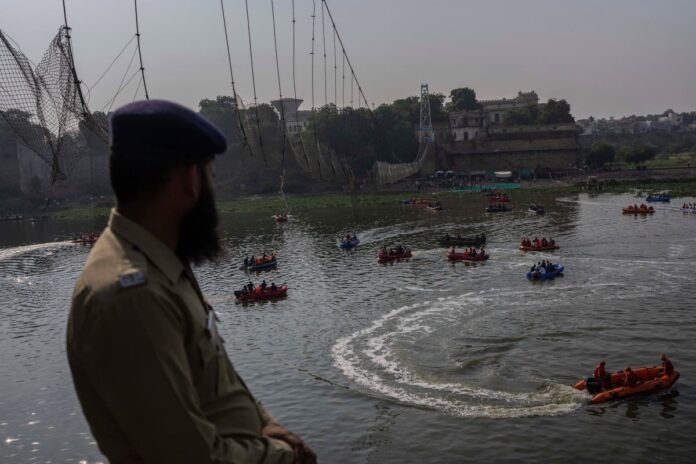Scuba divers combed through a river in western India on Wednesday to make certain no bodies were left behind after the collapse of a newly repaired suspension bridge, as officials investigate what led to the tragedy that killed at least 135 people. The 143-year-old pedestrian bridge collapsed Sunday evening, sending hundreds plunging into the waters of the Machchu River in Gujarat state’s Morbi town. As rescuers continue to search through the deep and muddy waters, questions have swirled over why the bridge collapsed and who might be responsible. The bridge, built during British colonialism and touted by the state’s tourism website as an ‘artistic and technological marvel,’ had reopened just four days earlier.As of Tuesday night, 196 people were rescued and all 10 of the injured were in stable condition. Officials said no one was missing according to their tally, but emergency responders and divers continued search efforts. ‘We want to be on the side of caution,’ Police Inspector-General Ashok Yadav had said. Prime Minister Narendra Modi arrived at the site Tuesday to inspect the collapsed bridge and visit injured people at a hospital. He also chaired a meeting with officials and urged for a detailed investigation into what went wrong. Police have so far arrested nine people – including managers of the bridge’s operator, Oreva Group – and have begun a probe into the incident. State authorities also have a case against Oreva for suspected culpable homicide, attempted culpable homicide and other violations.As families mourn the dead, attention has shifted to the quality of the renovation and repair work carried out by Oreva, a group of companies known mainly for making clocks, mosquito zappers and electric bikes.On Tuesday evening, prosecutors told a local court that the contractors who oversaw the repair work were not qualified, Press Trust of India news agency reported. Citing a forensic report, the prosecution said that while the bridge’s flooring was replaced, its cable was not and so it could not bear the weight of the new flooring, causing the cable to snap. In March, the Morbi town government awarded a 15-year contract to to Oreva to maintain and manage the bridge. The same month, Oreva closed the bridge for seven months for repairs. The bridge, which spans a wide section of the Machchu river, has been repaired several times in the past and many of its original parts have been replaced over the years. It was reopened Oct. 26, the first day of the Gujarati New Year, which coincides with the Hindu festival season. The attraction drew hundreds of sightseers.Sandeepsinh Zala, a Morbi official, told the Indian Express newspaper the company reopened the bridge without first obtaining a ‘fitness certificate.’ That could not be independently verified, but officials said they were investigating.A security video of the disaster showed it shaking violently and people trying to hold on to its cables and metal fencing before the aluminum walkway gave out and crashed into the river. The bridge split in the middle with its walkway hanging down and its cables snapped.It was unclear how many people were on the bridge when it collapsed. Survivors said it was so densely packed that people were unable to quickly escape when cables began to snap.Modi was the top elected official of Gujarat for 12 years before becoming India’s prime minister in 2014. A Gujarat state government election is expected in coming months and opposition parties have demanded a thorough investigation of the accident.India’s infrastructure has long been marred by safety problems, and Morbi has suffered other major disasters. In 1979, an upstream dam on the Machchu river burst, sending walls of water into the city and killing hundreds of people in one of India’s biggest dam failures.In 2001, thousands of people died in an earthquake in Gujarat. Morbi, 150 kilometers (90 miles) from the quake’s epicenter in Bhuj, suffered widespread damage. According to a report in the Times of India newspaper, the bridge that collapsed Sunday was also severely damaged in that earthquake.___Associated Press journalist Ajit Solanki contributed.


